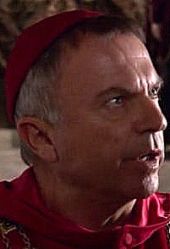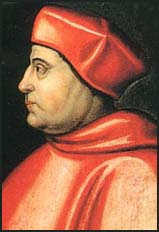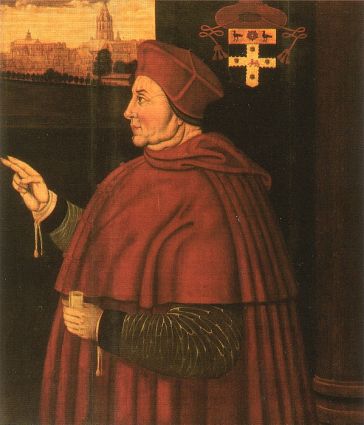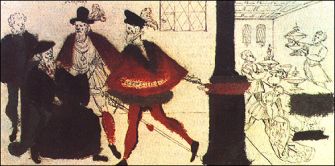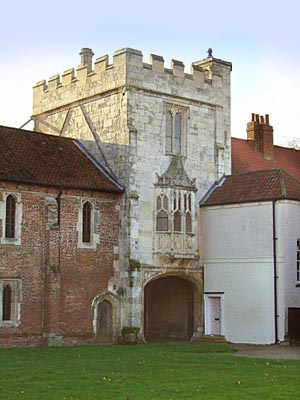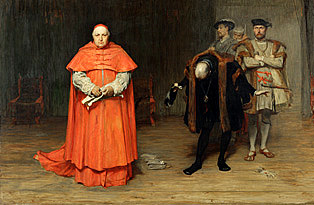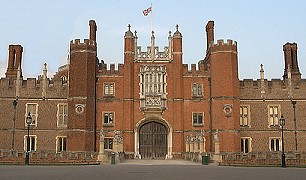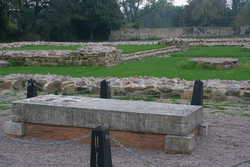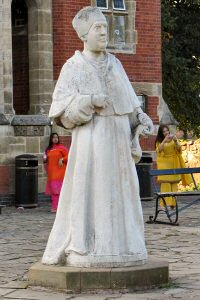Cardinal Thomas Wolsey Historical Profile
Jump to navigation
Jump to search
Save
| The History of Cardinal Thomas Wolsey c.1473 - 1530 (Aged 57) A man of "unbounded stomach"* Click EasyEdit to update this page! (Don't see the EasyEdit button above? <a href="/#signin" target="_self">Sign in</a> or <a href="/accountnew" target="_self">Sign up</a>.) |
INTERESTING FACTS:
|
In one letter, when Wolsey became aware of the King's displeasure with his failure to obtain the annulment he desperately wanted, he wrote: “If the Pope is not compliant, my own life will be shortened, and I dread to anticipate the consequences.” 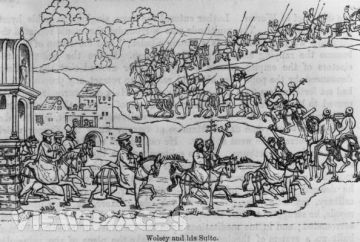 Circa 1520, Cardinal Thomas Wolsey & his suite of retainers riding out across the countryside. (Photo by Hulton Archive/Getty Images) | |
| Cardinal Wolsey surrendering the Great Seal (1529) From Cavendish's Life of Wolsey Roll 214.5. The Bodleian Library, Oxford. Cawood Tower as it appears today. Wolsey's last refuge. | In October 1529, Wolsey was officially stripped of the office of Lord Chancellor, and was required to return the Great Seal. Desperately trying to avoid indictment, Wolsey gave the King most of his property, including York Place, himself retiring to a modest house in Esher, Surrey. York Place was to be renovated, renamed Whitehall, and given to Anne Boleyn. In November Wolsey begged the King for mercy, and Henry, placated, placed Wolsey under his personal protection. Just after Christmas, Wolsey fell ill and was thought to be dying. The King sent him a message saying he “would not lose him for £20,000”, and the Cardinal's health improved. However, Wolsey was finally arrested on a charge of high treason in November. Travelling from Cawood, Yorkshire, to the Tower of London proved too much for Wolsey who fell ill on the way and died at Leicester Abbey. He is said to have said on his deathbed, “If I had served God as diligently as I have done the King, he would not have given me over in my grey hairs.” | |
| Letter from Henry VIII to Cardinal Wolsey. (c. 1527 - just before his disgrace) Mine own good cardinal,—I recommend me unto you with all my heart, and thank you for the great pain and labour that you do daily take in my business and matters, desiring you (that when you have well established them) to take some pastime and comfort, to the intent you may the longer endure to serve us, for always pain cannot be endured. Surely you have so substantially ordered our matters both of this side the sea and beyond, that in mine opinion little or nothing can be added. Nevertheless, according to your desire, I do send you mine opinion by this bearer, the reformation whereof I do remit to you and the remnant of our trusty councillors which I am sure will substantially look on it. As touching the matter that Sir William Says brought answer of, I am well contented with what order soever you do take in it. The queen my wife hath desired me to make her most hearty recommendations to you, as to him that she loveth very well, and both she and I would fain know when you will repair to us. No more to you at this time, but that with God's help I trust we shall disappoint our enemies of their intended purpose. Written with the hand of your loving master, HENRY REX. Source: Letters of the Kings of England. Vol I. J. O. Halliwell, Ed. London: Henry Colburn, 1846. 285-6. | LITERATURE:
LINKS:
| |
| During his career Cardinal Thomas Wolsey made many enemies. Many nobles were keen to see Wolsey’s departure from government in 1529 and his death in 1530. Although Wolsey was a very able man, most of his effort seemed to be concentrated on building up his own vast personal fortune & expanding his own power base at the expense of others. . His political power was immense. However, Wolsey was not so powerful that he was spared attacks that could be found in the written word. John Skelton (1460? – 1529) wrote a satire on Wolsey. Skelton was critical of the Church but even more critical of the most powerful man in the Church. Skelton would have been foolish to have verbally criticised Wolsey. He put his anger onto paper in the poem on the right aimed at Wolsey, despite his earlier support of the chief minister. The satirical poem on the right was written probably in 1523 and circulated accordingly. It caused such offence to Wolsey, who did not see the funny side of the poem, that it is said that Skelton was forced to take sanctuary at Westminster until 1529 when he died. However, there is no proof that this actually happened though Skelton did die in 1529. | Why come ye not to court? by John Skelton “In the Chancery, where he sits, But such as he admits, None so hardy to speek! He saith, “Thou hoddipeke, They learning is too lewd, Thy tongue is not well-thewd To seek before our Grace!’ And openly, in that place, He rages and he raves, And calls them ‘cankered knaves’! Thus royally he doth deal Under the King’s broad seal; And in the Chequer he them checks And in the Star Chamber he nods and he becks, And beareth him there so stout That no man dare rowt! Duke, earl, baron nor lord, But to his sentence must accord; Whether he be knight or squire, All men must follow his desire. Why come ye not to court? To which court? To the King’s court, Or to Hampton Court? Nay, to the king’s court! The King’s court Should have excellence But Hampton Court Hath the pre-eminence, And York’s Place, With my Lord’s Grace! To whose magnificence Is all the confluence, Suits and supplications, Embassades of all nations.” | |
| Hampton Court Palace built by Wolsey sometime between 1515 and 1530 | Wolsey's Grave at Abbey Park, leicestershire, England | |
The Cardinal Wolsey statue on the right stands in Abbey Park, Leicester, by the elegant bridge which crosses the River Soar. The statue was donated by the Wolsey hosiery company, one of Leicester’s major employers. They took their name from the Cardinal. In the early 1990s, the statue was decapitated by vandals. A new head was commissioned, and it is said that the new one is a much better likeness. | ||
Save
